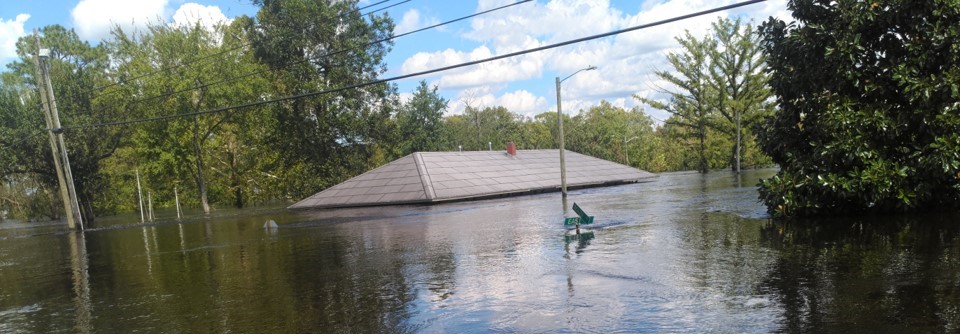Pollocksville reimagines future through resilient strategic plan, utilizing investments from ARP funds
The town of Pollocksville in Jones County is home to just about 300 residents, but there are big things happening in this small town between New Bern and Jacksonville. The Trent River flows along the northern city limit boundary, serving as both a boundary of the town limits and an integral part of the town’s identity. Pollocksville Mayor Jay Bender has lived his life in this town and been in the mayoral role since 1982, making him the currently longest serving mayor in North Carolina. He has seen the immense ways this body of water has impacted the town.
“Our greatest asset, I have said over and over, has been the Trent River,” Mayor Bender said. “Unfortunately, that wonderful asset that we have […] has proven to be our greatest liability because of the floods that we suffered under Hurricane Florence.”

The town experienced record flooding from Hurricane Florence in 2018, leaving some buildings under 21-feet of water. Yet even prior to this event, the town had been making plans to reimagine itself after it was announced that Highway 17 would soon bypass the town, a project that was completed in 2019. Pollocksville was working on creating this strategic plan for the future when the hurricane forced them to pivot directions and move their focus to some new projects, such as updating and floodproofing the town’s water and sewer system.
Much of the town’s water and sewer system is 50 years old, and town leaders knew updates were needed not only to the lines themselves, but also to relocate the wastewater treatment facility that is located in the Trent River floodplain. As they were securing grants to make some of the necessary improvements, they learned they would receive additional federal funding from the American Rescue Plan. Pollocksville received approximately $88,000 in ARP funds, which even for a small town, can only go so far in making updates to an aging infrastructure. But Pollocksville knew of a project that was in need of funding and could also be incorporated into the larger plan for the town and continue to extend the improvements they were already planning to make.
The town invested their ARP funds in a particular section of their water line where the system dead-ended and the water was not being recirculated, leading to a number of households who were dealing with sediment and poor tasting water. This project had been on the town’s list of needed improvements, so investing the ARP funds on this specific project was a simple decision for the town.
“It had been on our list of things to do, of capital improvements, and we knew about what it was going to cost. So when we got the notification of the $88,000 for ARP money, that was really kind of a no brainer,” Mayor Bender shared. “If for no other reason, $88,000 would have just been a drop in the bucket for some of the other projects that we had going, so this fit very well.”
Beyond the direct funds received from the ARP distribution, Pollocksville is also taking advantage of additional funds that have been made available through state-delegated ARP funds, receiving approximately $4.75 million in grants from the NC Department of Environmental Quality’s Division of Water Infrastructure. They combined this with another $5 million received from other grants in order to make extensive overhauls of the current water and sewer system, including the relocation of the town’s wastewater treatment facility out of the floodplain and elevating all of the town’s sewer pump stations to be out of flood danger.
Pollocksville recognizes that updating their water and sewer system and rebuilding after Hurricane Florence are large projects they will be undertaking, and in order to best put these funds to use, the town worked with North Carolina State University’s Coast Dynamics Design Lab to create an intentional design plan focused on recovery and resilience. This plan has helped to give Pollocksville a vision for the town and direction in how to best meet current and future needs. It’s a long-term plan to help move the town forward for years to come.
“It took about 72 hours of Hurricane Florence and floodwaters and rain and everything to tear our town apart. And I figure it's going to take 72 months to put it back. And we're making some real progress on that,” Mayor Bender said.
The plan began with the relocation of the Town Hall and the repurposing of the ground where it used to sit. The Town Hall was flooded during Hurricane Florence, so the building was moved across town to higher ground. The ground where the building was formerly located has now been turned into a wetlands space and a pastoral park.

Next, they moved on to some updates to Main Street by adding sidewalks, bicycle lanes, and street planting throughout a large portion of town. This project was enhanced by the repaving of Main Street by NCDOT, which had been promised following the completion of the Highway 17 bypass. Another $500,000 received from the Carbon Reduction Plan will help to further extend the sidewalks to the businesses within the town, greatly improving walkability.
Finally, the town has been promised another $1.08 million from FEMA’s Building Resilient Infrastructure and Communities (BRIC) program that will elevate the floors in a number of the town’s commercial buildings to prevent future flooding, which the town is hopeful will attract more businesses to their town. The flooding damaged about 75 buildings, yet nearly all have been repaired or rebuilt by residents and business owners in Pollocksville.
“We've had an amazing number of folks who remained in town. Seventy-five of our structures, residential and commercial, had anywhere from 4 inches to 21 feet of water […] I can only think of maybe one structure that was flooded that has not been repaired […] or rebuilt. And most of that was done by the people, the owners. They didn't leave; they stayed,” Mayor Bender said. “We made a lot of progress and mostly with people staying. And I'm very proud of that.”
Pollocksville continues looking towards the future as there is potential for development of the rural lands around the town, as well as commercial development along Highway 17 Bypass, and the town now feels they will be prepared to provide the utilities that would be necessary for that growth.










